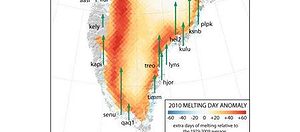
The data came from an array of 50 GPS stations scattered around the Greenland coast. Since the ice shelves which sit on top of the bedrock diminished, the weight exercised upon it diminished as well, which in turn caused this elevation. Greenland glacier melting might cause a worldwide sea level rise in the order of a quarter of a millimetre annually.
“Really, there is no other explanation,” Bevis argues. “The uplift anomaly correlates with maps of the 2010 melting day anomaly. In locations where there were many extra days of melting in 2010, the uplift anomaly is highest.”
The amount of uplift differed from station to station, depending on how close the station was to regions where ice loss was greatest, when correlated the researchers’ claim becomes evident.
Was this helpful?



